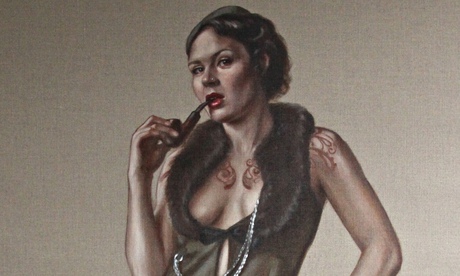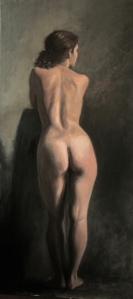“Inappropriate”, “bad taste”, “pornographic” or fine art?
The woman, one hand on her hip, the other holding a pipe to her lips, looks directly at the viewer with an air of confidence. She wears a fur-trimmed vest encircling the cleavage of her breasts, with her trousers dropped casually open at the waist, revealing a small strip of dark pubic hair.
The work was selected to hang in the gallery for the 153rd annual exhibition of the Society of Women Artist’s (SWA), but two days after a charity event and private viewing of the show, the piece was removed by the gallery, apparently “too pornographic and disgusting” for public display.
This image could be regarded as a beautiful one, with its carefully crafted brushstrokes and its finely rendered details, yet London- and Berlin-based artist Leena McCall’s Portrait of Ms Ruby May, Standing was removed from this year’s SWA exhibition at the Mall Galleries this summer, for fear that it may have corrupted and offended the public.
The Mall Galleries issued the statement:
“As an educational arts charity, the federation has a responsibility to its trustees and to the children and vulnerable adults who use its galleries and learning centre. After a number of complaints regarding the depiction of the subject and taking account of its location en route for children to our learning centre, we requested the painting was removed.”
Much of the controversy centred around why this picture was censored in the first place: Is it pornographic? Obscene? Is it too erotic for the general public? Is it because she is looking directly at the viewer and not submissive? Is it because she is partially clothed? Is is because she is not completely naked as in a classical “nude” painting? Is it because pubic hair is clearly displayed? Is it because she is smoking?
It is in the name of children and vulnerable adults that McCall’s Portrait of Ms Ruby May, Standing, was censored. The artist said that removing the piece from public view only serves to underline the precise issue she was trying to address, she said:
“My work deals with female sexual and erotic identity. The fact that the gallery has deemed the work inappropriate and seen it necessary to have it removed from public display underlines the precise issue I am trying to address: how women choose to express their sexual identity beyond the male gaze.”
Further, McCall’s commented that throughout art history, women’s sexuality is consistently portrayed as something for and controlled by men, and she seeks to challenge that paradigm. Her work is a deliberate attempt to use the traditional language of portraiture in a way that’s less patriarchal.
The gallery offered her the opportunity to replace her painting with another work, but she said that would be tantamount to admitting there was something wrong with it. Given the long history of the nude figure in art, particularly of the nude female figure, it is difficult to see why this was an issue. Indeed, compared to most music videos or advertisements today, there is less skin on display, and the woman’s breasts show less cleavage with her nipples not actually even visible.
Remarkably the painting was replaced by another nude painting, so obviously the nudity itself was not the issue. It seems that the pose of the subject was the reason for the complaint and subsequent removal of the painting from the exhibition.
The replacement was another, less provocative, nude: no tattoos, unbuttoned clothing or brazen attitude, suggesting that the Mall Galleries‘ clientele can cope with nudes, as long as the model is passive and unthreatening to a (male?) viewer’s gaze. This has been described as “a desperately outmoded form of prudishness, like the wartime strippers at London’s Windmill club who were allowed to pose naked, by the Lord Chamberlain’s reluctant acquiescence, so long as they didn’t move. They posed with one foot forward, obscuring any glimpse of “the fork” (ie vulva). The implication’s clear: the minute a woman is alive and free to move, an active agent of her own sexuality, she is a menace to society.”
Ruby May, the subject of the painting, said:
“I don’t think people realise how threatening a sexually empowered woman is to a paradigm that is still patriarchal at its roots. Thankfully, the world is evolving, this outdated paradigm is crumbling, and forms of censorship such as this are becoming unacceptable to the wider public.”
The executive secretary of the SWA, Rebecca Cotton, said:
“We thought the painting was beautifully executed and the composition was much admired. We saw nothing wrong with it; had we, the piece would not have been selected. We hire the gallery space from the Mall Galleries for the period that the show is on. The gallery took it down without seeking our approval.”
Society today teaches young women that they should be waxed, shaved, buffed and polished to perfection, such messages are pervasive and uncensored. In such a world view, girls grow up believing that beauty equals pain, to be sexy is a hairless, pre-pubescent ideal, and boys expect girls to look like submissive porn stars.
McCall’s Ruby is not size zero, like the models used to sell clothes to women aged 14-years-old upwards. Ruby does not lie submissively with her legs splayed like the centrefold of a lad’s magazine; she is not made of silicone or plastic and there is no overt sexuality: she’s beautiful, confident, and real.
The Mall Galleries may have been “thinking of the children”, yet hiding the human body, when shown so positively and in an empowering way, does nothing for a child’s awareness, safety or self-belief.
McCall is understandably incensed at the censoring of her portrait: it is ironic that her work should be removed from an all-female exhibition, curated by women.
When contacted via her website, the artist explained that:
“Ruby May (who leads erotic workshops) had proudly wanted to own the pubic hair that is so often waxed, covered or air-brushed away in contemporary depictions of the female body – and rarely glimpsed in classical ones, come to that… [one] can’t begin to understand how a painting that reveals no intimate flesh, other than the pelvic triangle, could possibly be described as pornography.”
The artist subsequently launched a social media campaign asking supporters to contact @mallgalleries using hash-tag #eroticcensorship – to see if she can get people talking about sexuality in that medium instead.
Writing on Twitter, McCall described the move as “erotic censorship”, adding; “How is this painting ‘pornographic’ and ‘disgusting’?” Twitter users lamented the “19th century Victorian ideas” at play, and asked: “How is that any more outré than classical nudes?”
One wonders if those (men?) responsible for censoring and removing the portrait have ever seen Gustave Courbet’s L’Origine du Monde at the Musée d’Orsay, with its splendid sprawl of black-haired vulva, or indeed Britain’s much loved Stanley Spencer’s Self Portrait with Patricia Preece, and what they make of them.
References and further reading
- http://www.society-women-artists.org.uk/
- http://leenamccall.com/
- http://www.mallgalleries.org.uk/
- http://news.artnet.com/in-brief/society-for-women-artists-show-censored-over-pornographic-painting-53474
- http://www.theguardian.com/lifeandstyle/2014/jul/07/painting-pornographic-pubic-hair-outrage#
- http://www.standard.co.uk/news/london/artists-painting-of-woman-showing-pubic-hair-is-removed-from-london-gallery-over-taste-concerns-9593054.html
- http://www.independent.co.uk/voices/comment/censoring-art-as-pornographic-because-it-shows-pubic-hair-is-ridiculous-9595098.html
- http://www.independent.co.uk/arts-entertainment/art/pornographic-and-disgusting-painting-removed-from-top-london-exhibition–because-it-features-a-womans-pubic-hair-9592705.html
- http://www.fitzmuseum.cam.ac.uk/pharos/collection_pages/20th_pages/PD.966-1963/TXT_SE-PD.966-1963.html
- http://www.telegraph.co.uk/news/worldnews/europe/france/9855914/Even-at-35-million-the-missing-head-of-LOrigine-du-Monde-adds-nothing.html







